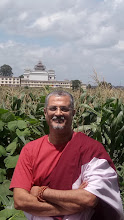Our life on earth in this human life can be compartmentalized into three processes or gross states: First, our waking state in which we go to work, do domestic chores, experience enjoyment and do other worldly activities. Second, is our sleeping state which comprises sleep and dream states. And third, the state or process of dying which comprises the sub-processes of cessation of outer and inner respiration, intermediate state and after life.
‘Kaya’ means body. However, when we use this term in Buddhist tradition we do not really refer it to as any physical body or form. It is referred to as dimension, aspect or field. It can also be called bardo, meaning transition or simply a transitory or ‘inbetween’ moment. (‘Bar’: interim, ‘do’: present). Let us briefly explore their meanings.
• Dharma-kaya: The Buddha body of Reality: This is the true nature of our mind, ‘empty’ and unadulterated in anyway. The absolute state or the ground of our being or absolute truth.
• Sambhoga-kaya: The Buddha body of Perfect Resource: This state is the rich, abundant, radiant and resonant nature of our base mind.
• Nirmana-kaya: The Buddha body of Emanation: This refers to the unimpeded arising of our mind in whatever form it may manifest into.
It is amazing to see how these three ‘bodies’, states or bardos are with us all the time and during all the three states of waking, sleeping and dying. If we actually playback this is slow motion or in tiny sections we observe so:
Waking State: We usually associate this state with either everyday activity and/or during meditative practice where we maybe actually observing rising and falling of thoughts and emotions. After the passing of one thought or emotion and before another arises, there is a state which is pure and fresh. There is a possibility here to catch a glimpse of the true nature of our mind. This is the Dharmakaya state. However, this state does not last long. There is a stirring of energy in the mind and another possibility of thought or emotion arises. This is the Sambhogakaya state. And finally this latent possibility can arise into any form of thought or emotion as we begin to cling on to this arising energy. This is the Nirmanakaya state.
Sleeping state: When we fall asleep our various levels of gross conscious states dissolve slowly and the true nature of mind, our base mind opens before us as the Dharmakaya state. Then there is a brief period when we are actually asleep and just before dreams begin to manifest. This is a very subtle experience as many of us are unable to recognize when exactly we fall asleep and the moment at which dream state begins. This is the intermediate stage of Sambhogakaya. As dreams begin – something that many of us don’t know when exactly this happens after we fall asleep – there are many fantasies, experiences that we may go through. Some of these are driven by occurances of the waking state and we live them actively in our dream as though real. The Nirmanakaya state.
Dying process: Although one might argue as to how it is possible to ‘see’ or experience what state of our mind is when we are dying or dead, the fact is that the three dimensions are miraculously revealed at that time too! At the moment of death, when our inner respiration stops there is a moment when the nature of mind (emptiness) is revealed to us as Dharmakaya. Thereafter, as Sambhogakaya, the radiance of the intermediate state through light, colour and sound manifests. And finally, the formation and manifestation of the Nirmanakaya or creation in after life or that of becoming manifests.
It is clear therefore that each state, in both life and death, there exists exactly identical and unending opportunities to be able to release ourselves from conditioned existence towards Nirvana or continue in its state of confusion in Samsara. By this argument, it is further clear that life and death are therefore seamless experiences, one cascading into the other continuously, propelled by our karma.
The task before us is to recognize these intermediate states by getting some control over our minds and maintain continued awareness over it, work on these recognitions continuously, with the help of teachings and practices. In doing so, the doors of liberation will certainly open.
Monday, February 28, 2011
Subscribe to:
Post Comments (Atom)

No comments:
Post a Comment